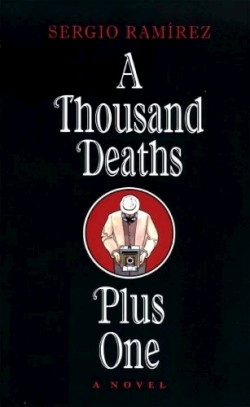A Thousand Deaths Plus One
- 2009 INDIES Finalist
- Finalist, General (Adult Fiction)
Originally published in Spanish in 2004 this is the most recent novel by an author generally agreed to be among the foremost Latin American literary figures at work today. Nicaraguas premier living writer Sergio Ramirez has played an important role in the countrys intellectual and political history for decades: he led the Group of Twelve who sparked the 1979 Sandinista revolution against the Somoza regime and subsequently became vice-president of Nicaragua a post he held until political differences with President Daniel Ortega prompted him to retire from government. Since 1963 he has published thirty works of fiction and nonfiction but only a few have been translated into English.
As one might expect of a man whose books have won many major awards A Thousand Deaths Plus One is an accomplished novel ably translated by Leland H. Chambers. Intricate and initially somewhat baffling it weaves together three basic storylines all anchored in the first person which skillfully evoke the history of Nicaragua over the past century and a half even though much of the action is set in Europe.
The framing device describes the author himself in the recent past as he becomes fascinated by an early-twentieth-century Nicaraguan-born photographer named Castellon. Castellon tells the story of his own family beginning in the mid-nineteenth century when English French and American interests vied to build a canal across Central America. Panama was ultimately chosen as its site but for a while Nicaragua was under serious consideration and thus attracted more attention from the Great Powers than its culture and development would ordinarily have commanded. Ramirez introduces memories of Castellon from sources of uncertain reliability. This combination of perspectives creates a hall-of-mirrors effect raising questions about truth identity and narrative-both literary and historical.
Many and perhaps most of the characters are actual figures: Prince Louis Napoleon (later Napoleon III); William Walker an American mercenary who tried to create a private empire in Nicaragua; national poet Ruben Dario; and Castellon himself who roistered through Europe until he wound up in a Nazi concentration camp as an old man. These tales unfold in an offhand often elliptical style mingling storytelling literary history psychology and philosophy in a thought-provoking though sometimes rather opaque fashion.
This is decidedly literary fiction of greatest appeal to readers who can leap with the author from Chopin to Turgenev to the Central American jungle to Mautthausen. Those who are familiar with Ramirezs next-most-recent novel in translation Margarita How Beautiful the Sea will have an idea of what to expect: serious yet playful challenging and rewarding writing for anyone who wants to sample the best of todays Spanish-language fiction.
Reviewed by
Teresa Scollon
Disclosure: This article is not an endorsement, but a review. The publisher of this book provided free copies of the book to have their book reviewed by a professional reviewer. No fee was paid by the publisher for this review. Foreword Reviews only recommends books that we love. Foreword Magazine, Inc. is disclosing this in accordance with the Federal Trade Commission’s 16 CFR, Part 255.

